I never thought.... I've been saying that quite a bit lately. I never thought so many people would send me halters, lead ropes, wormer, syringes, and even hay. I never thought that so many people would paypal or drop a check in the mail to validate what I do and help with the gelding costs on these 6 intact male llamas that need to be done immediately. So far, in monetary donations we have close to $750 towards their gelding. I called the vet today, they originally couldn't get the guys gelded until April 8th but they are going to squeeze them in tomorrow for me. Four of them will be able to go out with the herd that they are familiar with by this weekend. The other two studs will probably have to be confined longer to cool their jets before they will go out with the herd and be "civilized". The computer emails and the phone continue to bring pleas for help ... there are sheep, geese, and several more llamas coming in but none are emergencies and I would prefer to blog about what is here--not what is coming.
I never thought that a bunch of guys in their early 20s (most were High School Volunteers here) would want to stand on scaffolding 12 foot in the air and work on the ceiling of the indoor part of our new raptor facility. We have just about 100 feet of the ceiling done. This weekend, between our two fund-raising events, we hope to finish the ceiling and get the 9 posts put in. Once that is done, we can finish individual pens as time and money allows. My goal is to have the 8 indoor raptor pens done by summer. The outdoor flight that is connected to the inside individual species aviaries will be the largest flight aviary in the Northeast (that I am aware of): over 100 feet of enclosed, open free-flight space. It will be crucial for rehabbing raptors (hawks, owls, falcons) for release back into the wild. Everyone has been very impressed with what we are doing here. I have a vision and we are well on our way there. It takes time and money--but doesn't everything? We have gotten a lot of interest lately from people of all ages that want to volunteer at our facility. This is no longer a one-man show and the volunteers have been a huge help keeping the constant facility expansion moving forward, and tackling a variety of other chores. "The guys" are probably not going to read this but if you do, thanks for giving up your weekends to keep the raptor center going.
I never thought that I would get a call to save a Seagull; we are a long way from any substantial body of water. Last night, after dinner, our phone rang (it does that a lot lately) . My daughter Hannah got the expression on her face she always gets when we get a wild animal rescue call. I took the call and the caller said that a Seagull had been hit in the road in front of the convenience store where she worked, on Main St. in Schoharie. Schoharie is not close to a beach but it isn't that unusual to see seagulls in the valley during the spring. I actually await their arrival as a sign of spring. They fly in from the Hudson River (or elsewhere?) and they scour the valley for whatever might be thawing out of the ice, take advantage of the snacks, and leave....
I am anxiously awaiting for my chance to rehab some black bear cubs but I wasn't expecting to do any seagull rehab anytime soon. :) I suggested that they try to get it in a box where it would be safe and told Sue that I would be there in 5 minutes. I actually went to the wrong Mobil Mart, (there are only 4 gas stations in Schoharie) first. I was beginning to wonder which one of my friends was messing with me when we pulled into the right convenience store with a box sitting by the door. The top of the box was open and I peered in to see a seagull looking back at me. It had anexpression like: "Where the hell have you been", and "Don't get any ideas pal". I reached in the box and got a good beak bite--much to the amusement of my daughter. After I got him off my hand, I did a "once over" and was happy to see that they were no broken wings or legs. Other than a pretty bad foot injury, the bird was not in bad shape. We got home and got him settled in; I am pretty confident that this guy will be releasable. I never thought that all of those people would just drive around a hurt gull in that parking lot on Main Street. One woman named "Sue" cared enough to get the seagull safe, call me, and do the right thing. I am fortunate: I get to meet a lot of people like Sue.
I also want to take a moment as I end this blog to thank Joan and Allan for adopting an alpaca. They have adopted a dozen llamas from me and they decided to add a camelid cousin to their collection. They also opened up their doors to 4 muscovy ducks that needed a home. They are great people and it makes it all worthwhile watching animals go home with them .
I never thought when I started saving animals as a kid that it would progress to this. I never thought that we would grow to be the not for profit facility that we are today--with the help of our Board Of Director, volunteers and supporters, I look forward to the next several months of further expansion.
Till next time,
Wes
Please also see our other blog at
http://nywildliferescue.blogspot.com/
It is more active than this one. Always check there for updates, too.
Northeast Llama Rescue was started by Wes and Darcy Laraway of Middleburgh, NY.
Several years ago they rescued their first llama out of a tiny horse pen. Since that day, Northeast Llama Rescue has helped dozens of Camelids from several different states. The primary mission of Northeast Llama Rescue is to educate owners on how to properly care for their animals.
We also offer assistance with a traveling chute to shear, worm, and trim toenails on hard to handle animals. A 'TRUE REPUTABLE BREEDER" should help out the llama down the road that is not being cared for by owners that understand the needs of llamas.
If you know of a llama owner who is no longer able to care for their animals, there is help available. Members of Northeast Llama Rescue will adopt any unwanted animals. Rescue animals will be relocated to farms of members for training and necessary vet work.
If a llama is able to be rehabilitated, he will be available after a careful screening process. All rescues are placed in homes with a contract that says they shall be provided for and can not be sold. In the event a rescue animal becomes unwanted, the llama MUST be returned to Northeast Llama Rescue.
If you share our philosophy and love for the animals, you are more than welcome to join us! There are lots of llamas that need a person to love.
We also rescue farm animals, and are licensed wildlife rehabilitators.
This site is copyrighted by Wes Laraway.
Wednesday, March 25, 2009
Subscribe to:
Post Comments (Atom)
Northeast Llama Rescue by Wes Laraway
The Northeast Llama Rescue was started by Wes and Darcy Laraway several years ago after they rescued their first llama out of a tiny horse pen. Since that day, the Northeast Llama Rescue has helped dozens of animals in 5 states. The primary mission of Northeast Llama Rescue is to educate owners on how to care for their animals properly. We also offer assistance with a traveling chute to shear, worm and trim toenails on hard to handle animals. If owners get "tired" of the daily maintenance of their herds, members of the Northeast Llama Rescue will adopt or buy, if possible, any unwanted animals. Rescue animals go to the farms or members of the organization.
The Northeast Llama Rescue does not wish to compete with other rescue organizations, although any llama or alpaca is welcome. We need to cooperate to help ALL camelids, not just registered or "nice-looking" ones. Everyone has the right to breed and sell llamas, but a true reputable breeder will "help out" the llama down the road that is not being cared for, regardless of its age, sex or conformation.
Our last rescue came from Central New York. A farm had purchased 9 animals from a Midwest auction. Four of the animals had died from natural causes....starvation? The owner had health problems and no longer wanted the animals. After several other concerned people failed to negotiate their sale, I eventually called and within five minutes we had agreed on a price and the deal was done. The next night, Wes Laraway, Kim Scheurerman and P.J. Wagner went to pick up the animals. The owner informed us that the llamas were wild and could not be handled. Within five minutes all were calmly caught, on lead ropes and in the trailer, with us using a wand and some TEAM Training techniques. The owner thought I was the "llama whisperer" because I got those llamas to do things in five minutes that she couldn't do in a year. She unfortunately knew nothing about handling llamas.
Three hours later, we were back into quarantine at Red Maple Farm starting "damage control". The animals were immediately wormed, fed fresh hay and grain, and watered. All were body scored under three by sight and by feeling through their wool. This hands-on inspection revealed barbed wire that needed to be cut out of the fiber. We decided NOT to shear because it was too late in the year and they were too thin.
Another concern was an ingrown halter. One of the best ways to remove ingrown halters is to undo the buckle(s) and cut the nose band with sharp toenail clippers on each side of the nose. Then gradually, over time, the remaining pieces will fall out. With application of an antibiotic cream, any wounds from the ingrown halter will heal quickly. In this particular case, the halter came out of the nose and was added to the "wall of shame" in our barn (along with the barbed wire and ear tags still on them from the auction they were purchased from). The blood stream stopped within fifteen minutes and now, after a month, we can tell that scarring will be minimal. Please tell everyone you know that owns camelids, NEVER leave a halter on a llama! Even in a week, with wet conditions, a halter can embed itself in a llama's nose.
My biggest concern was the 10 month old female that was exposed to her father. If bred, we decided to abort the unborn cria for the safety and well-being of the young female. None of these five animals were over the age of three years. All of them, over the following months, would need intense care and proper nutrition. The animals were all updated on health requirements and gelded. All of these animals would need training before they could go up for adoption.
New problems continuously arose. Two weeks after they arrived, one of the females surprised us with a weak, constipated fourteen pound male cria. Within hours I knew it wasn't "normal" so mom and baby were moved to a quarantine pen in the barn. The decision was made to supplement the cria with goat colostrum and give him an enema. Although the cria was walking, he continued to strain to relieve himself. Around the clock surveillance did not reveal any nursing or defecation. At two days old, I found very small maggots between the cria's toes and by his umbilical cord. After consulting my vet again, the cria got a bath and dried out in the heated office before going back to mom in the barn. My vet explained that crias born on rainy days must be completely dry or flies will lay eggs in moist areas of umbilical fluid. I've never heard of this problem before but I know now to check my newborn crias for maggots every day. After five days of constant care, we lost "Trooper"....I guess it was not meant to be, but we tried.
The rest of the animals are doing well today. Concerned individuals found them, bought them and will protect them. Today is actually a special day, because the vet did fecals on them and all five of them are parasite free and can join our llama herd. After training and further rehabilitation, by Spring 2001 this group of animals will be available for adoption to carefully approved homes. All animals sold or placed by Northeast Llama Rescue will be adopted with a legal contract. The contract states that if the llama ever becomes unwanted or is not cared for properly, the animal will return to Red Maple Farm for a full refund. I used to think I could save every unwanted llama in the world...I know that I can't . It is too great an undertaking for one farm to rescue all the unwanted camelids out there. For this reason, several other farms have joined in the effort with Red Maple Farm to pool resources and save neglected and unwanted camelids.
Any farm that shares our philosophy that every llama deserves a life with proper care is welcome to join us. We are people who genuinely love all llamas and want to make a difference one llama at a time. Eventually we will print an educational brochure to hand out at events with member farms listed. Don't just tell people that you love your llamas; show people by making a difference and actually save one. Always quarantine new animals for at least one month while getting wormings, vaccines and nutritional needs in order. Always do a fecal exam and consult your vet about when new animals should go out with the herd. Geld all males and most of all BE PATIENT. Llamas are very forgiving animals and will learn to love and trust again with gentle care and training.
The Northeast Llama Rescue does not wish to compete with other rescue organizations, although any llama or alpaca is welcome. We need to cooperate to help ALL camelids, not just registered or "nice-looking" ones. Everyone has the right to breed and sell llamas, but a true reputable breeder will "help out" the llama down the road that is not being cared for, regardless of its age, sex or conformation.
Our last rescue came from Central New York. A farm had purchased 9 animals from a Midwest auction. Four of the animals had died from natural causes....starvation? The owner had health problems and no longer wanted the animals. After several other concerned people failed to negotiate their sale, I eventually called and within five minutes we had agreed on a price and the deal was done. The next night, Wes Laraway, Kim Scheurerman and P.J. Wagner went to pick up the animals. The owner informed us that the llamas were wild and could not be handled. Within five minutes all were calmly caught, on lead ropes and in the trailer, with us using a wand and some TEAM Training techniques. The owner thought I was the "llama whisperer" because I got those llamas to do things in five minutes that she couldn't do in a year. She unfortunately knew nothing about handling llamas.
Three hours later, we were back into quarantine at Red Maple Farm starting "damage control". The animals were immediately wormed, fed fresh hay and grain, and watered. All were body scored under three by sight and by feeling through their wool. This hands-on inspection revealed barbed wire that needed to be cut out of the fiber. We decided NOT to shear because it was too late in the year and they were too thin.
Another concern was an ingrown halter. One of the best ways to remove ingrown halters is to undo the buckle(s) and cut the nose band with sharp toenail clippers on each side of the nose. Then gradually, over time, the remaining pieces will fall out. With application of an antibiotic cream, any wounds from the ingrown halter will heal quickly. In this particular case, the halter came out of the nose and was added to the "wall of shame" in our barn (along with the barbed wire and ear tags still on them from the auction they were purchased from). The blood stream stopped within fifteen minutes and now, after a month, we can tell that scarring will be minimal. Please tell everyone you know that owns camelids, NEVER leave a halter on a llama! Even in a week, with wet conditions, a halter can embed itself in a llama's nose.
My biggest concern was the 10 month old female that was exposed to her father. If bred, we decided to abort the unborn cria for the safety and well-being of the young female. None of these five animals were over the age of three years. All of them, over the following months, would need intense care and proper nutrition. The animals were all updated on health requirements and gelded. All of these animals would need training before they could go up for adoption.
New problems continuously arose. Two weeks after they arrived, one of the females surprised us with a weak, constipated fourteen pound male cria. Within hours I knew it wasn't "normal" so mom and baby were moved to a quarantine pen in the barn. The decision was made to supplement the cria with goat colostrum and give him an enema. Although the cria was walking, he continued to strain to relieve himself. Around the clock surveillance did not reveal any nursing or defecation. At two days old, I found very small maggots between the cria's toes and by his umbilical cord. After consulting my vet again, the cria got a bath and dried out in the heated office before going back to mom in the barn. My vet explained that crias born on rainy days must be completely dry or flies will lay eggs in moist areas of umbilical fluid. I've never heard of this problem before but I know now to check my newborn crias for maggots every day. After five days of constant care, we lost "Trooper"....I guess it was not meant to be, but we tried.
The rest of the animals are doing well today. Concerned individuals found them, bought them and will protect them. Today is actually a special day, because the vet did fecals on them and all five of them are parasite free and can join our llama herd. After training and further rehabilitation, by Spring 2001 this group of animals will be available for adoption to carefully approved homes. All animals sold or placed by Northeast Llama Rescue will be adopted with a legal contract. The contract states that if the llama ever becomes unwanted or is not cared for properly, the animal will return to Red Maple Farm for a full refund. I used to think I could save every unwanted llama in the world...I know that I can't . It is too great an undertaking for one farm to rescue all the unwanted camelids out there. For this reason, several other farms have joined in the effort with Red Maple Farm to pool resources and save neglected and unwanted camelids.
Any farm that shares our philosophy that every llama deserves a life with proper care is welcome to join us. We are people who genuinely love all llamas and want to make a difference one llama at a time. Eventually we will print an educational brochure to hand out at events with member farms listed. Don't just tell people that you love your llamas; show people by making a difference and actually save one. Always quarantine new animals for at least one month while getting wormings, vaccines and nutritional needs in order. Always do a fecal exam and consult your vet about when new animals should go out with the herd. Geld all males and most of all BE PATIENT. Llamas are very forgiving animals and will learn to love and trust again with gentle care and training.











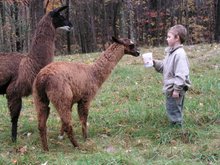
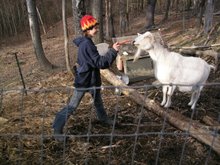

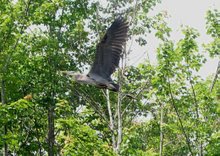

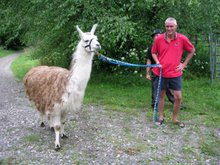
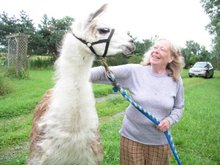
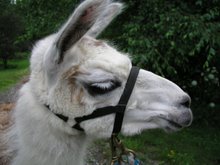








No comments:
Post a Comment